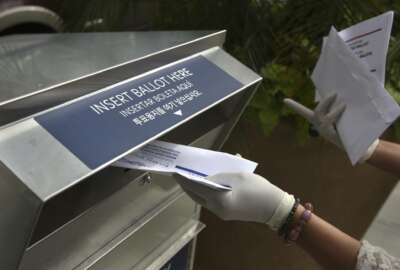

After months of President Trump calling on the Postal Service to increase prices for commercial customers, the agency has agreed to seek rate hikes.
After months of President Donald Trump calling on the Postal Service to increase prices for its commercial package customers, the agency has agreed to seek rate hikes that would last through the end of the year.
The Postal Service is asking the Postal Regulatory Commission to approve a temporary price increase for its commercial package business that’s substantially lower than the president’s request to quadruple those rates. The rate change, if approved, would go into effect Oct. 18 and last through Dec. 27.
The Postal Service has seen a surge in package delivery during the coronavirus pandemic that has given the cash-strapped agency enough funds to keep operating through August 2021, according to its most recent financial filings.
However, USPS has also seen a 25-30% decrease in mail volume and expects billions in pandemic related losses this year, worsening its long-term financial problems.
“The planned temporary price adjustments are in response to increased expenses and heightened demand for online shopping package volume due to the coronavirus pandemic and expected holiday ecommerce,” USPS wrote in a press release Friday.
The USPS Board of Governors approved the rate hike last week, and would raise prices on commercial domestic competitive parcels – including Priority Mail Express, Priority Mail, First-Class Package Service, Parcel Select, and Parcel Return Service.
The rate increase won’t affect retail package prices.
Postmaster General Louis DeJoy has put several key management changes in motion since taking office in June. During his tenure, USPS has also sought to cut overtime and transportation costs, leading in some cases to mail delays.
More recently, USPS announced a reshuffling of 23 executives, a hiring freeze on new management and early retirements for non-union postal employees.
Meanwhile, Trump in April set an ultimatum for USPS in April, telling the agency to increase package prices on e-commerce businesses by “approximately four times” as a condition for receiving a $10 billion loan guaranteed in the CARES Act.
USPS and Treasury Department officials reached an agreement on the loan terms, but in exchange, Treasury gained access to the agency’s top 10 negotiated service agreements with industry for both for its competitive and non-competitive products.
Despite the Trump administration’s repeated concerns that that Postal Service doesn’t charge companies like Amazon its fair share, the agency is legally required to make a profit on its package business, and the Postal Regulatory Commission reviews NSAs to ensure the deal’s profitability.
Mike Plunkett, the president and CEO of the Association for Postal Commerce, told Federal News Network that the announcement wasn’t a “huge surprise,” since the agency’s private-sector competitors have also introduced surcharges to keep delivering packages during the pandemic.
The association, he added, had advised members earlier in the pandemic that increased prices on package service might be on the way.
The surge in package volume has helped the Postal Service generate enough cash on hand to keep operating through August 2021, but has also seen increase workforce costs to deliver that many parcels. Packages have made up about 30% of the Postal Service’s total revenue for the past few years.
However, Paul Steidler, a senior fellow at the Lexington Institute, said USPS will probably continue to see a heightened level of package business.
“The price increases are not at all surprising. Americans are turning to e-commerce at accelerating rates and with the pandemic likely to be with us until at least the end of the year, e-commerce demand will stay exceptionally strong for some time,” Steidler said.
Kevin Kosar, the vice president of research and partnerships for the R Street Institute, noted that the package price increase reflects the fact that more of USPS’ overhead costs are now tied to its package business.
The rate hikes, he added, are modest compared to the president’s “inherently unreasonable” proposal to quadruple package prices.
“It will be interesting to see what effect the increases have on USPS’s parcel volume,” Kosar said. “Will volume decline at all? It might not be a bad thing for the USPS to have fewer parcels to handle. The agency gives the appearance that it is struggling to handle the current crush of packages.”
Copyright © 2025 Federal News Network. All rights reserved. This website is not intended for users located within the European Economic Area.
Jory Heckman is a reporter at Federal News Network covering U.S. Postal Service, IRS, big data and technology issues.
Follow @jheckmanWFED

